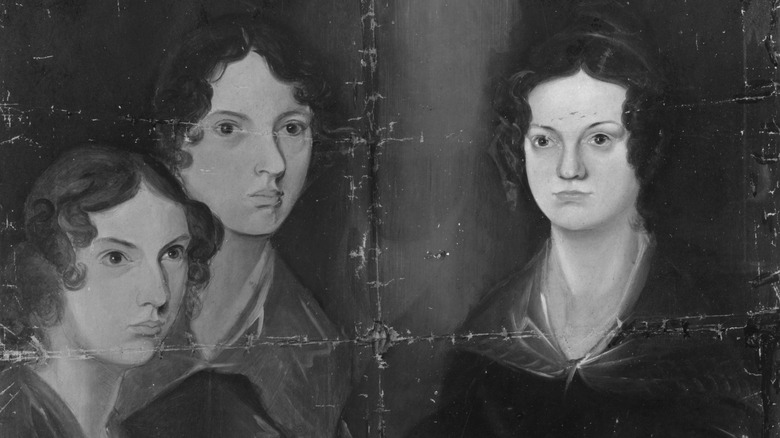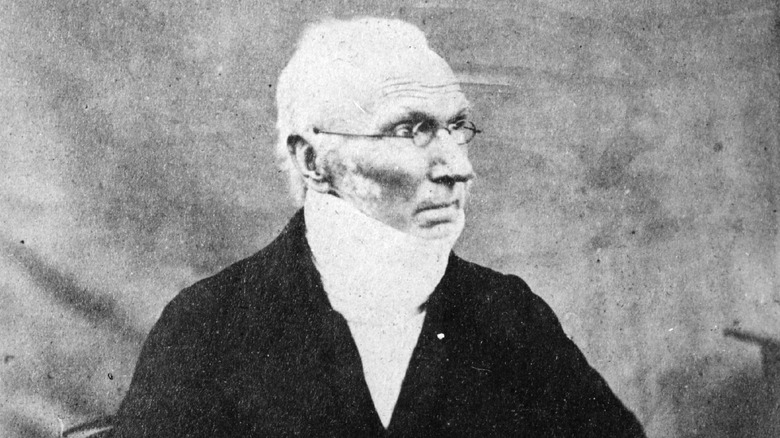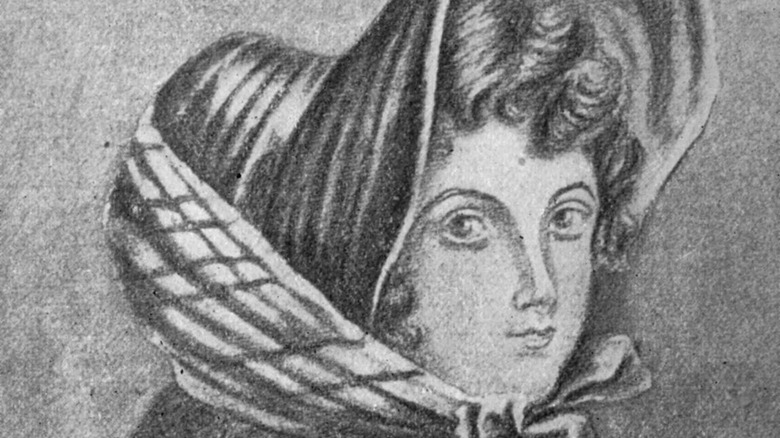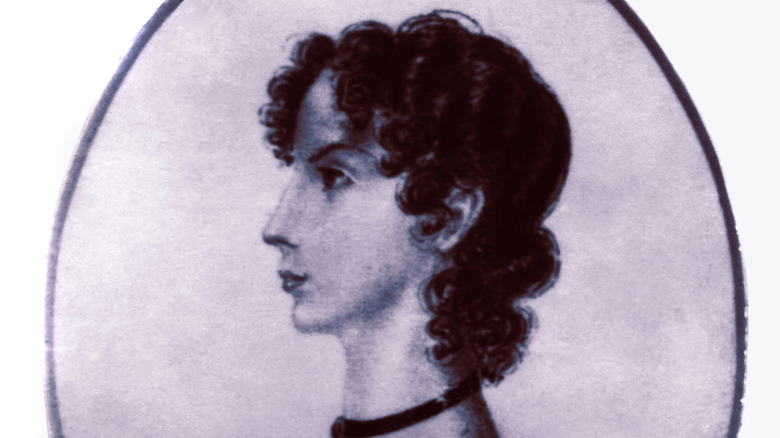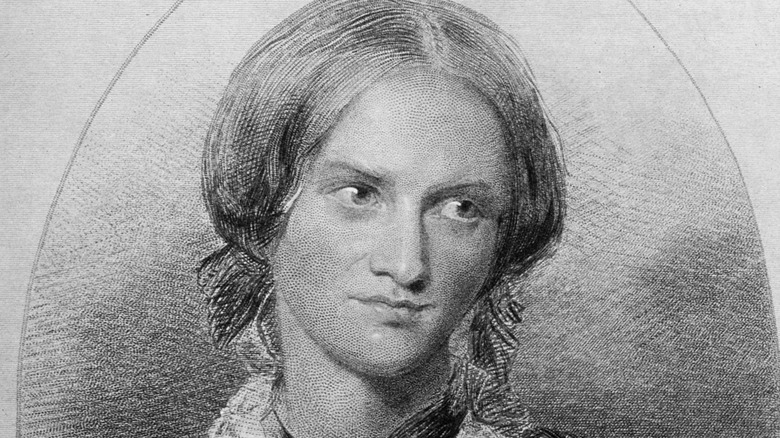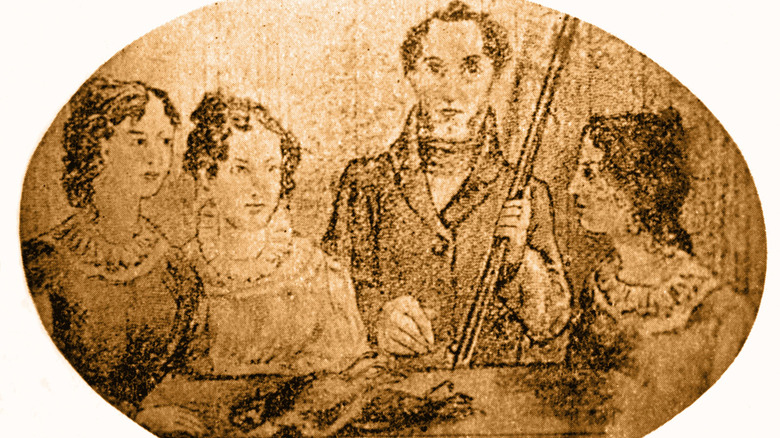The Brontë Sisters' Family Tree Explained
Anne, Charlotte and Emily Brontë became literary legends despite facing challenges and tragedies. The three grew up in a modest home in Yorkshire during the Victorian era — a time period not often kind to progressive women. As children they suffered terrible losses, with their mother, Maria, dying of ovarian cancer in 1821. Charlotte was 5, Emily was 3, and Anne, almost 2, said History Extra. Their two eldest sisters succumbed to tuberculosis four years later. The girls lived with their minister father, Patrick, brother Branwell and Aunt Branwell, their mother's sister, in a parsonage sandwiched between a graveyard and the moors in Haworth. The family stayed here for more than four decades, and the setting infiltrated the family's artistic works. The Brontë sisters layered it into their books and their brother painted its beauty, as well as the portrait above (via The Genealogy Show).
"The sisters were all very close indeed, because their interests were so similar and they were all so pathologically shy. Emily and Anne were almost like twins," said Juliet Barker, author of "The Brontës," according to History Extra. The group loved creating imaginary lands together. Despite their love for one another, by the 19th century, the Brontë family line — a onetime flourishing family tree — ended, undone by scandal, troubled lives, a reluctance to marry and a failure to reproduce, asserted The Genealogy Show. Patriarch Patrick would see all his children perish before dying in June 1861.
The Brontë patriarch: an Irishman settles in England
Brontë was not Patrick's true family name. Many believe the original might be Brunty or Prunty. Some also think the Brontës' lineage traces back to the Irish clan Ó Pronntaigh, quite apropos since the group was known as scribes and scholars, reported The Genealogy Show.
His father, Hugh, settled in County Down, became a farmer, and married Eleanor (or Alice) McClory. They had 10 children, including the eldest, Patrick, born in 1777. As a teen, he apprenticed with a blacksmith and a weaver. Patrick leaned toward learning, though, and by 16 he oversaw the local school. Although poor, Patrick earned a spot in at St. John's College in Cambridge. He returned home, just once, after graduating in 1806. Ordained in 1807, he served several curacies before moving to Haworth Parsonage in 1820. He married Maria Branwell (1812), and they had six children: Maria, Elizabeth, Charlotte, Patrick Branwell, Emily Jane and Anne (from Brontë Parsonage Museum).
After Maria's death, her sister, Elizabeth, moved in to help with the children. An overwhelmed Patrick sent four of his daughters to the Clergy Daughters' School, said Haworth Village. The institution provided harsh conditions, offering poor food and little heat and the girls returned home. Patrick fought for reform, campaigning for improved education in 1847 and a better water supply in 1849. He gave his last sermon on October 30, 1859 — he had preached in the local church for 41 years. He died on June 7, 1861.
Emily Brontë: A poet and novelist who published one book
Despite the popularity of Emily's only published novel, "Wuthering Heights," its arrival in 1847 underwhelmed, according to The Guardian. The publication quoted several, including: "The incidents are too coarse and disagreeable to be attractive" (from the Spectator); "In 'Wuthering Heights' the reader is shocked, disgusted, almost sickened" (via Douglas Jerrold in the Weekly Newspaper); and "How a human being could have attempted such a book as the present without committing suicide before he had finished a dozen chapters, is a mystery" (Graham's Lady's Magazine). The denouncements bothered sister Charlotte so much that she created a preface for the 1850 edition revealing that Emily was behind the pseudonym "Ellis Bell" and apologized for her sister's work.
Born 1818, Emily was the fifth child in the family. She and her sisters enjoyed creative pursuits. Emily and Anne created an imaginary world called Gondal that they described in their writings. The three women even published a book of poetry in 1846 under the pen names, Currer, Ellis, and Acton Bell. It sold few copies and had little acclaim. "Wuthering Heights" only became famous after Emily's death. She died from tuberculosis on December 19, 1848 (from Biography).
Anne Brontë: The sometimes forgotten sister
The sixth and youngest child in the Brontë family is less known than her literary powerhouse sisters, yet she probably started writing novels before them, asserted Book Riot. Some even believe her "Agnes Grey" influenced Charlotte's "Jane Eyre" and called her second novel, "The Tenant of Wildfell Hall," the first feminist work of fiction.
As a daughter of a vicar with a modest salary, Anne needed to work. She became a governess, a job that inspired her writing. Her first job proved difficult, and she was terminated before a year passed. Her next position, for the Robinson family, lasted for five years, according to The Guardian. Anne left only after her brother, Branwell, whom she recommended as a tutor for the son, began an affair with Mrs. Robinson. When she returned home she and her sisters actively wrote, and regularly critiqued each other's developing work: Anne's "Agnes Gray," Charlotte's "The Professor" and Emily's "Wuthering Heights."
Anne also proved unlucky in love, according to the Anne Brontë website. She admired William Weightman, her father's assistant curate, but he died from cholera. Emily died in December 1848; Anne died a few months later, in May 1849, from tuberculosis, the same disease that felled her sister. She was just 29.
Charlotte Brontë: A successful author who married later in life
When a 20-year-old Charlotte Brontë sent her work to England's Poet Laureate, Robert Southey, his recommendations failed to her inspire her. He believed she should stop writing and said, "Literature cannot be the business of a woman's life, and it ought not to be. The more she is engaged in her proper duties, the less leisure will she have for it, even as an accomplishment and a recreation." She continued writing anyway. Her seminal book "Jane Eyre" was published in 1847; she earned $500 for it, about 25 times more than she received as a governess (via Cliffs Notes).
Born on April 26, 1816, Biography called her the most ambitious of the Brontë sisters. Like her female siblings, she tried earning a living by becoming a governess and teacher but returned home after missing her family too much. She published "Jane Eyre" using the name Currier Bell. Its success led to two more books, "Shirley" in 1848 and "Villette" in 1853. Her first novel attempt, "The Professor," was published in 1857 after her death.
She lived with her father and married later in life to A.B. Nicholls, her father's curate. At first her father objected to the engagement, but he warmed to the idea of their union, reported Victorian Web. She became pregnant in 1854, but died from pneumonia before the baby was born.
Patrick Branwell Brontë: The family black sheep
Patrick Branwell Brontë, mostly known by his middle name, was the only boy of the family. Born in 1817, his life was marked by scandal and alcoholism. An intelligent child, according to The Brontë Parsonage Museum, he was homeschooled and sought to become a portrait painter. By 1838, he had rented a studio and actively networked in the Bradford artistic community, but he failed to make the endeavor a success. He tried several jobs, including work as a tutor and a clerk, but frequently was dismissed from his positions. By the age of 27, he returned home after allegedly having an affair with the wife of his employer.
Branwell turned to alcohol and opiates for comfort. He died on September 24, 1848, most likely from tuberculosis. He's often depicted as a failure compared to his sisters, and is known for antics like setting his bed on fire, according to the The Guardian. Still, he provided inspiration for his sisters. His legacy as an artist continues, too — the only painting of the three Bronte sisters that exists is the one he created that hangs in London's National Portrait Gallery (from Independent).
